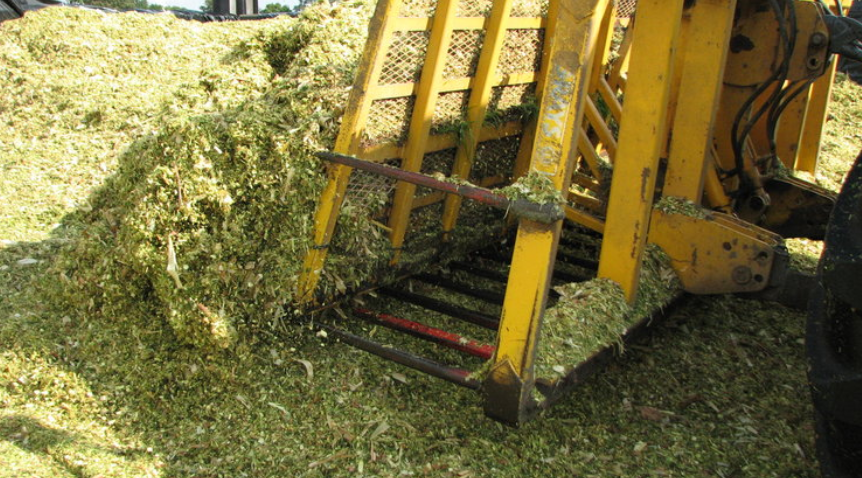Forage maize offers high yields per hectare from a single harvest and is an excellent source of starch.
However, it is important to preserve it well – especially if short on other forages or bought-in feeds.
Nutritional value
There is enough energy in a hectare of fresh forage maize to support about 30,000L of milk production in dairy cows, once animal maintenance needs are met, says Volac business manager, Ken Stroud.
However, he says the typical loss of dry matter (DM) that occurs in maize clamps during storage is equivalent to between one and two trailer loads out of every 10 originally ensiled.
“Typical losses in maize clamps run at about 15% of the DM ensiled,” says Ken. “Though they can be higher.
“The most obvious loss occurs when maize silage heats up, caused by yeasts and moulds feeding on the silage in the presence of air. But hidden losses also occur due to poor fermentation, which can account for at least 8% of this overall DM reduction.
“Also, it’s not just tonnes of DM at stake. Silage feed quality will also be reduced, and uncontrolled moulds can make silage unpalatable, leading to cows rejecting it, as well as causing problems with mycotoxins.”
Harvesting
With these types of losses at stake, Ken says it should be a “no-brainer” to take utmost care when ensiling maize, especially if grass silage is short this year.
Good preservation starts at harvest, he says. Harvesting crops promptly at the optimum 30-33% DM content, chopping to optimum 1.5-2cm lengths, and avoiding cutting plants too low.
“Following best practice harvest guidelines not only optimises the nutrient content of maize, it also sets the crop up for better preservation,” Ken explains.
“Cutting at higher percentage DMs and using longer chop lengths both make it more difficult to compress air out of the crop during consolidation, which encourages yeasts and moulds.
“This year, it will be particularly important to monitor maize maturity closely, so that you can get your contractor in before crops become over-ripe.”
Additive use
The next step is to make sure you’re using the correct type of additive, stresses Ken.
“My advice is to safeguard maize with an additive that not only reduces heating but also improves fermentation efficiency,” he says.
“Ecocool, for example, applies two strains of beneficial bacteria. The first is the same bacterium as in Ecosyl, for fermentation. The second bacterium inhibits yeast and mould growth.
“Indeed, Ecocool has been shown to significantly delay maize silage heating. This is important because for every 1º rise in clamp temperature, 0.23% of DM is lost per day.
“With modern maize varieties tending to stay green at harvest, there is an argument they need extra help with fermentation; while in drier maize, heating becomes more problematic.
“Another common mistake people make is not ordering enough additive or not bothering to mix up a final batch if the machine runs out early. Either of these will leave the last few trailer loads on the vulnerable top part of the clamp less well protected.
“Usefully, Ecocool can be applied in ultra-low volumes of water with the appropriate applicator, which makes mixing up a final batch easier.
“It can also be used on other silages, such as wholecrop and grass – so any bottles left over can easily be used on the last few loads of grass going into the clamp that tend to be drier, or on bales made at certain percentage DM.”
Clamping
Maize preservation also often goes wrong during clamp filling, says Ken.
“Take time to consolidate clamps thoroughly and seal fully,” he urges. “Not only to starve spoilage organisms of air but also to aid the fermentation.
“To squeeze air out, you need to consolidate to a density of 700kg of fresh maize per cubic metre. To aid this, fill in horizontal layers a maximum of 6in deep. A second machine consolidating the clamp is vital to achieve this consistently.
“Better consolidation also allows more silage to fit in the clamp, which is important because anything above the walls is difficult to roll.
“After excluding air from the clamp, don’t let it back in again. As well as a top sheet, use an oxygen barrier film on top of the silage and side sheets down to the floor.
“Finally, place a woven sheet over the clamp to prevent damage, weight down properly and cover with netting to stop birds pecking holes and letting in air.”
Further information
For more information on Ecosyl, just click here
For additional information on Cut To Clamp, simply click here




